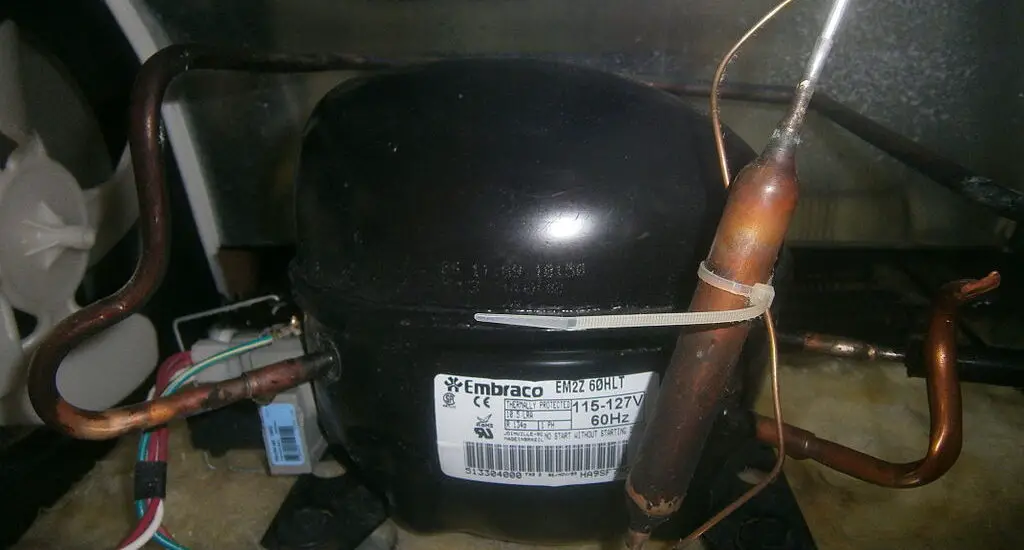Is your refrigerator compressor upside down? This in-depth guide details the subsequent steps for remediation and provides you with peace of mind.

Steps to Rectify the ‘Refrigerator Compressor Upside Down’ Situation
If you suspect or discover your refrigerator compressor upside down, taking prompt corrective action is crucial. Follow these steps methodically:
Power Down Safely: Before any intervention, ensure the refrigerator is turned off and unplugged. This step guarantees your safety from potential electrical hazards.
Comprehensive Inspection: With safety ensured, closely examine the compressor’s orientation. An upside-down position is an immediate cue for corrective measures.
Reorientation Procedure: With caution and potentially additional hands for assistance, gently reposition the compressor to its correct orientation. Ensure it sits securely in its designated spot after adjustment.
Rest and Recovery: After realigning the compressor, don’t rush to power it on. Allow the unit several hours of rest. This hiatus facilitates any displaced oil to trickle back into its designated chamber.
Monitor After Powering On: Once restarted, keep a vigilant eye on the refrigerator’s functioning for a day or two. Any anomalies or reduced cooling efficiencies should be a cue to consult a technician.
Preventing Future Issues
Prevention, they say, is better than cure. To mitigate future compressor orientation issues, here are some guidelines:
Upright Transportation: Always transport refrigerators in an upright position. Even if circumstances demand a slight tilt, never lay it completely horizontally or upside-down.
Rest Period Post-Tilting: If, for any reason, the refrigerator is tilted, ensure you give it ample time (preferably several hours) to rest in its upright position before powering it on. This allows any unsettled oil to return to its chamber.
Regular Maintenance: Periodic checks and maintenance by professionals can preempt many issues, including potential misalignments or problems stemming from them.
Check out these other articles…
Refrigerator Compressor Leaking Water: Fixed in 6 Easy Steps
Causes of Refrigerator Compressor Overheating: Easy Guide
5 Signs of Refrigerator Compressor Failure: Ultimate Guide
RV Refrigerator Compressor Not Coming On: Easy Steps to Fix
Everchill RV Refrigerator Compressor Not Working: How to Fix
Why Position Matters
The orientation of the refrigerator compressor is not a trivial design decision. Its position plays a pivotal role in the efficient operation of the entire cooling system. Here’s why:
Optimal Functionality: Compressors are precisely engineered to function in a designated position. This orientation ensures that the internal components, especially the lubricating oil, remain in their intended places.
Lubrication Distribution: The compressor contains oil that lubricates its moving parts. If misaligned, this oil can escape its designated compartment, leading to friction, increased wear, and potential component failures.
Pressure Management: The compressor operates under specific pressure parameters. When oriented incorrectly, these pressures can change, affecting the refrigeration cycle and the overall cooling performance.
Potential Impacts of an Upside-Down Compressor
An improperly oriented compressor doesn’t merely result in diminished cooling efficiency; it can have more far-reaching consequences. Let’s explore them:
Oil Intrusion: The cooling tubes are meticulously crafted to house the refrigerant. When oil seeps in due to misorientation, it hampers the cooling process, leading to uneven or diminished cooling.
Expedited Wear and Tear: The oil’s primary function is to lubricate. When it’s not where it’s supposed to be, the compressor’s components can rub against each other, causing premature wear and potential breakdowns.
Refrigerant Complications: An upside-down compressor might lead to internal pressure changes. This can cause refrigerant leaks, which are both hazardous for the environment and detrimental to the cooling process.
Complete Compressor Failure: Continual strain on the compressor due to incorrect positioning can eventually lead to its complete failure, necessitating expensive replacements.